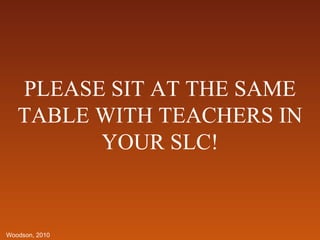
Sw Pbs Presentation
- 1. PLEASE SIT AT THE SAME TABLE WITH TEACHERS IN YOUR SLC!
- 2. School-wide Positive Behavior Support Maynard Jackson High School August 3, 2010 Cornell F. Woodson
- 3. Agenda What is School-wide Positive Behavior Support (Sw-PBS)? How do we implement it here in our SLCs? What has it done in schools across the country? Getting started
- 4. Today’s Goals Identify all areas of the SLC Layout expectation for behavior in those areas Identify which areas are the biggest problems Identify the most frequent behavior issues Design temporary plan for dealing with behavior problems in the SLC
- 5. Today’s Norms Stay focused Be mindful that others will want to share their thoughts Be open-minded Be honest Use “I” statements that reflect your own story
- 7. What is Sw-PBS? Positive Behavior Support (PBS) is a set of research-based strategies used to increase quality of life and decrease problem behavior by teaching new skills and making changes in a person's environment. http://www.apbs.org Sw-PBS refers to a systems change process for an entire school or district. The underlying theme is teaching behavioral expectations in the same manner as any core curriculum subject. http://pbis.org/school/swpbs_for_beginners.aspx Essentially, it is using the same strategies we were all trained to use. The difference here, in my opinion, is that it involves using data to target areas and students, it involves collaborative efforts across the SLC, and it involves placing systems in place that could prevent behavior problems. Teaching strategies? Classroom management strategies?
- 8. Tertiary Prevention : Specialized Individualized Systems for Students with High-Risk Behavior Secondary Prevention : Specialized Group Systems for Students with At-Risk Behavior Primary Prevention : School-/Classroom- Wide Systems for All Students, Staff, & Settings School-Wide Positive Behavior Support ~80% of Students ~15% ~5%
- 10. How Do We Implement it Here? STEP 2 Consistency from class to class and adult to adult is very important for successful implementation of Sw-PBS. Therefore, we all need to agree on our behavioral expectations. Then we create a matrix of what the umbrella behavioral expectations look like, sound like, and feel like in all the areas that our students interact with during the day. This matrix will have approximately three positively stated examples for each area. Here is an example line from one school:
- 11. How Do We Implement it Here? STEP 3 The next step is deciding how we will explain our expectations to the students. Most importantly, everywhere they go they need to see our expectations. The SLC needs to be covered with things that remind them of what that SLC is all about. SLC Town Hall Meeting SLC Pep Rally Skits done by teachers Our expectations need to be visuals throughout the SLC.
- 12. How Do We Implement it Here?
- 13. How Do We Implement it Here? STEP 4 Streamline the discipline referral process using Infinite Campus. We need to decide what are things that teachers can handle themselves in the classroom and what are things that a student would need to be referred for. Major Cursing at a teacher or student Hitting teacher or student Minor Talking in class Throwing paper
- 17. How Do We Implement it Here? STEP 7 Now we need to start collecting data and using that data to guide our decision-making throughout the year. Who - 9th, 10th, 11th, 12th What - Cursing, cutting class, lateness, cell phone use, fighting When - Monday, Tuesday, Wednesday, Thursday, Friday, spring time Where - Cafeteria, classroom, parking lot, bathroom
- 18. PBS in Other Schools Positive school environment Decreased number of behavioral referrals Better relationship with students High morale in teachers and administrators alike Prevention of current behavior problems from becoming worse
- 19. Getting Started - Group Activity What are the most severe behavior issues your SLC faces. Where are these issues happening most often. (Classroom, hallway, etc.) What systems are you going to implement as a team of teachers to combat it. (What changes need to be made?) What are your behavior expectations? (Be respectful, Be Responsible, etc.) What support do we need from administration to make this work?
- 20. Questions???
- 21. Contact Information: Room 130 - Information Technology SLC Cell: 609.605.8274 Home: 404.963.6014 E-mail: woodsonc@atlanta.k12.ga.us
